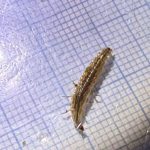Notice: Below is a list of 0 important links included on this page.
Please note that while screen readers have made significant strides, they may still lack full support for optimal web accessibility.




The first sighting came from a first-time Glow Patrol member who noticed a faint glow on the ground rather than in flight. As we looked closer, we found more glowing spots and managed to lean over the platform and extend a net to capture one for photo identification.
One theory is that these larvae enter diapause and later emerge as our April adults. We were surprised to see how long the larvae were in comparison with how small the luficera adults are. It was a very exciting night for everyone!
You must be logged in to post a comment.
This is a project of the Xerces Society, working in collaboration with the IUCN SSC Firefly Specialist Group and New Mexico BioPark Society.
Copyright © 2025 The Xerces Society •1631 NE Broadway Street, #821 • Portland OR 97232 USA
Very nice find! There is a nice comparison photo of a Pyractomena lucifera larva on page 20 of this publication by Larry Buschman.